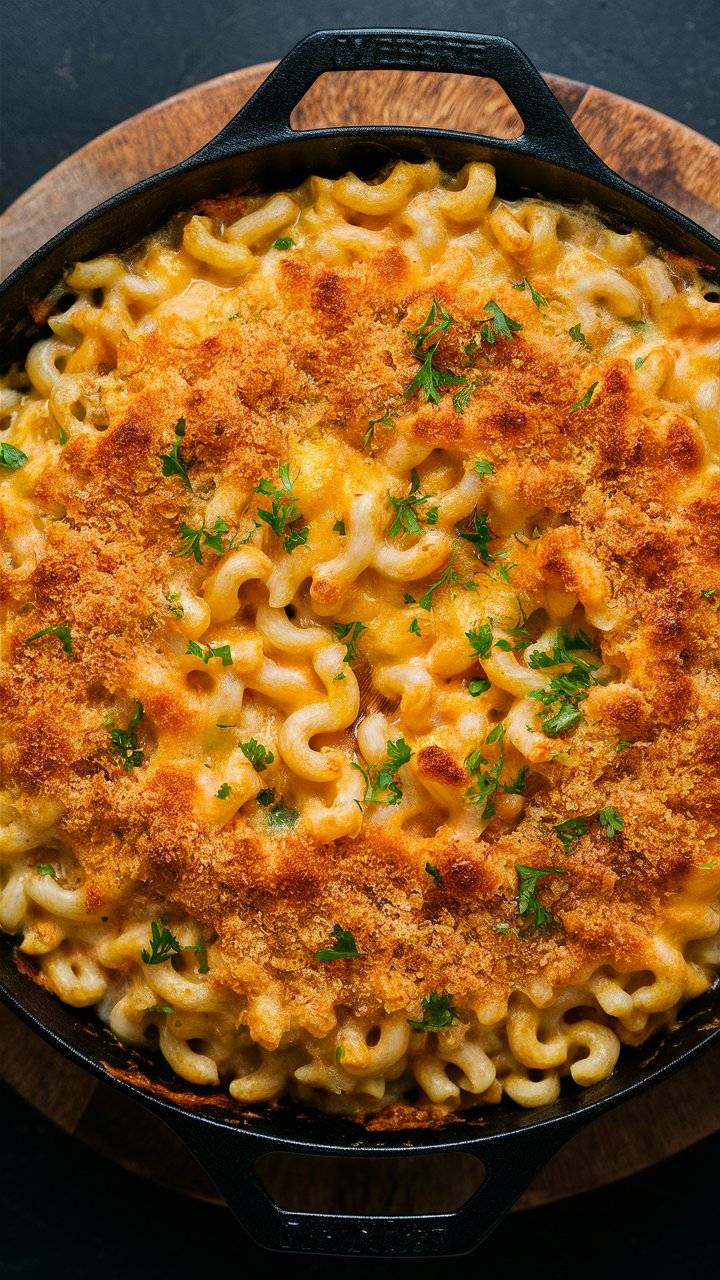
Step-by-Step Guide to Caramelized Onion Mac and Cheese 2025
There’s something truly magical about mac and cheese—the creamy, cheesy sauce, the tender pasta, and that irresistible golden crust baked to perfection. But when you add slow-cooked, caramelized onions into the mix, the classic comfort dish transforms into a sophisticated, flavor-packed meal that’s both nostalgic and elevated.
Whether you’re serving it as a cozy dinner for family, a show-stopping side at a dinner party, or a satisfying vegetarian main, this Caramelized Onion Mac and Cheese will impress anyone who takes a bite. The sweetness of the onions, the richness of the cheese, and the herby crunch on top all come together in a harmonious dish that’s pure indulgence.
In this comprehensive guide, we’ll cover everything from ingredients and expert tips to variations, storage, FAQs, and even pairing suggestions—ensuring your mac and cheese is creamy, flavorful, and unforgettable every time.
Why This Caramelized Onion Mac and Cheese Stands Out
Not all mac and cheese is created equal. Here’s why this recipe is in a class of its own:
- Deep, caramelized flavor: Slowly cooking the onions unlocks their natural sweetness and complexity, adding a rich depth to every bite.
- Perfectly creamy texture: The béchamel-based cheese sauce clings to every piece of pasta without being too thick or too runny.
- Golden, crunchy topping: A combination of Parmesan, breadcrumbs, and fresh herbs gives that satisfying crunch that contrasts beautifully with the creamy interior.
- Versatility: Works as a vegetarian main dish or an elegant side for roasted meats, grilled chicken, or baked salmon.
- Crowd-pleasing flavor: It’s indulgent comfort food with a grown-up twist, making it perfect for potlucks, family dinners, or special occasions.
Ingredient Highlights: What You’ll Need
Each ingredient plays a vital role in flavor, texture, and richness:
Sweet Onions
Cooked slowly over low heat, sweet onions develop a deep, caramelized flavor that forms the foundation of this dish. Their natural sugars add complexity to the creamy sauce.
Olive Oil & Butter
Start with olive oil for flavor and a touch of richness. Adding butter later enhances the sauce and provides a velvety texture.
Short-Cut Pasta
Elbows, shells, or penne work best because they hold onto the sauce and allow the cheesy goodness to coat every bite.
Flour & Milk
A classic béchamel base forms the creamy sauce. Using warm milk helps the roux thicken faster and prevents lumps.
Nutmeg
A pinch of nutmeg adds warmth and subtle depth, balancing the richness of the cheese.
Gruyère Cheese
Gruyère melts beautifully and adds a nutty, slightly sharp flavor that elevates traditional mac and cheese.
Parmesan Cheese
Adds saltiness and bold flavor, enhancing the overall taste.
Seasoned Breadcrumbs
For a golden, crispy topping that contrasts the creamy interior.
Fresh Thyme
Adds a herby, fragrant note to tie all flavors together.
Pro Tips Before You Start
- Slice onions thinly and evenly to ensure uniform caramelization.
- Don’t rush the caramelization—low and slow is key. A rushed process can result in burnt or unevenly cooked onions.
- Grate cheese freshly to avoid clumping and ensure smooth melting.
- Use warm milk in the roux to speed up thickening.
- Let it rest for 5–10 minutes after baking so the sauce sets and the dish holds its shape.
Step-by-Step Guide to Perfect Caramelized Onion Mac and Cheese
Step 1: Start the Onions
Heat olive oil in a large oven-safe skillet over medium heat. Add thinly sliced onions with a generous pinch of salt. Cook until softened, stirring occasionally.
Step 2: Caramelize Low and Slow
Reduce heat and continue cooking for about 60–75 minutes. Stir frequently to prevent burning, and add a splash of water if the onions start to dry out. The result should be deep golden, soft, and sweet onions.
Step 3: Preheat and Boil Pasta
Preheat your oven to 375°F (190°C). Cook pasta according to package directions, then drain and set aside.
Step 4: Set Onions Aside
Transfer caramelized onions to a plate. If you’re short on time, a touch of sugar or honey can speed up caramelization, but slow-cooking yields the best flavor.
Step 5: Make the Roux
In the same skillet, melt butter. Whisk in flour and cook for 2–3 minutes until golden. Gradually add warm milk, whisking constantly until thickened. Stir in a pinch of nutmeg.
Step 6: Add the Cheese
Stir in most of the Gruyère and Parmesan until melted. Add most of the caramelized onions and fold in the cooked pasta.
Step 7: Assemble and Bake
Top with reserved cheese, remaining onions, and breadcrumbs. Bake for 25–30 minutes until golden and bubbly.
Step 8: Finish and Serve
Sprinkle with fresh thyme and serve warm.
Serving Suggestions
- Crisp green salad with vinaigrette
- Roasted Brussels sprouts or broccoli
- Garlic bread or rustic baguette
- Pair with dry white wine or sparkling apple cider
- Serve as a side with grilled chicken or baked salmon
Variations and Substitutions
- Swap Gruyère for sharp cheddar or Swiss
- Use thyme, rosemary, or chives for different herb flavors
- Add sautéed mushrooms, spinach, or roasted red peppers
- Make it gluten-free with gluten-free pasta and flour
- Include crispy bacon or pancetta for a smoky twist
Storage and Reheating
- Store in an airtight container in the fridge for up to 4 days
- Reheat in the oven at 350°F or in short microwave bursts
- Add a splash of milk before reheating to loosen sauce
- Freeze for up to 2 months; thaw overnight and bake
- Bread crumb topping may lose crispness—consider sprinkling fresh crumbs before reheating
Frequently Asked Questions
Can I caramelize the onions in advance?
Yes! Store them in the fridge for up to 3 days.
What pasta shape works best?
Short shapes like elbows, shells, or penne hold sauce beautifully.
Is Gruyère necessary?
Delicious, but Swiss or sharp cheddar can be substituted.
Can I make this ahead for a party?
Absolutely. Assemble, refrigerate, and bake when ready to serve.
How can I make it spicy?
Add crushed red pepper flakes to the sauce or a drizzle of hot sauce on top.
What’s the best way to reheat leftovers?
The oven preserves texture best—cover with foil and heat at 350°F.
Is it vegetarian-friendly?
Yes, just ensure the cheese is made without animal rennet.
Extra Tips for the Perfect Mac and Cheese
- Layer flavors: Toast breadcrumbs with a little butter and thyme before topping for extra aroma.
- Experiment with cheeses: Mixing Gruyère, sharp cheddar, and Fontina creates a complex flavor profile.
- Don’t overcrowd the skillet: Pasta needs space for the sauce to coat evenly.
- Check seasoning: Taste your béchamel and adjust salt, pepper, and nutmeg before baking.
- Presentation matters: Garnish with fresh thyme or chives for a professional finish.
The Science of Caramelized Onions
Caramelizing onions isn’t just cooking—they’re undergoing a Maillard reaction, where sugars and amino acids break down to form rich, brown flavors. Low, slow heat ensures onions soften and sweeten without burning. This step is what transforms simple mac and cheese into a luxurious, deeply flavorful dish.
Pairing Wine and Drinks
- White Wine: Chardonnay or Sauvignon Blanc balances creaminess.
- Beer: A malty amber ale or lager complements cheesy richness.
- Non-Alcoholic: Sparkling apple cider or herbal iced tea refreshes the palate.
Conclusion: Why You’ll Love This Recipe
This Caramelized Onion Mac and Cheese is more than just comfort food—it’s elevated, elegant, and deeply satisfying. The sweet onions, creamy cheese sauce, and crispy, herby topping come together to create a dish that’s perfect for cozy dinners, family gatherings, or special celebrations.
With detailed steps, expert tips, and endless variations, this recipe ensures your mac and cheese is always creamy, flavorful, and show-stopping.

